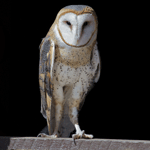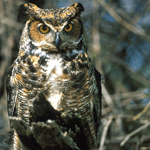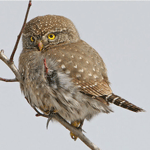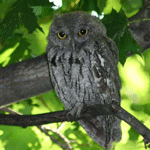|
All of the world’s owls fall within two families. The majority are in the family Strigidae, with the Barn Owl (Tyto alba) the sole members of the family Tytonidae. Overall, the owls exhibit much less variety of form and specialization than do the diurnal raptors. However, owls do vary in size, from the tiny Elf Owl to the large Great Gray Owl and despite being overwhelmingly nocturnal, there are exceptions to that rule. What follows is a brief summation of the different owl species that can be seen, or more likely heard, in Redwood National and State Parks.

USFWS Barn Owl If you happen to be checking out one of the historic barns in Redwood National and State Parks, you might just startle a barn owl off its roost. Barn owls are relatively long-legged, and pale to the point of appearing almost white. Barn owls hunt mainly on the wing, patrolling open areas in search of rodents. 
ODNR Great Horned Owl This Master of the Night is the largest owl to be found in Redwood National and State Parks. The Great Horned (Bubo virginianus) is the quintessential “hoot owl” with its low “hoo-hoo-hoo”. It is found in wooded habitats and may be seen perched in silhouette at dusk. It hunts mammals as large as skunks and rabbits from a perch. 
IFG Northern Pygmy Owl The Northern Pygmy Owl (Glaucidium gnoma) is the one diurnal owl present in Redwood National and State Parks. It is an aggressive bird-hunter, and may take prey up to twice its size. It is usually heard before seen, calling with a series of fast, high “toot” notes from high in an oak and conifer wood. Once heard, it sometimes may be spotted calling from its perch. 
IFG Northern Saw-whet Owl The Northern Saw-whet Owl (Aegolius acadius) is a highly nocturnal owl and consequently, seldom seen. Often hidden within the deep coniferous woods, the Northern Saw-whet is one of the smallest owls residing in Redwood National and State Parks. It may be identified by its loud, methodical “toot-toot-toot....” which may go on for minutes at a time as it perches high in a tall tree. 
USGS The Spotted Owl (Strix occidentalis) and the Barred Owl (Strix varia) are closely related species with a rather complex and unique story. Learn more about this here. Just a few decades ago it would have been common to hear or even see a spotted owl in Redwood National and State Parks. Now Spotted Owls are very rare in the parks; as they have been displaced and replaced by the Barred Owl. The Barred Owl is a relative newcomer to the western United States, after expanding from its historic range in the eastern U.S. It’s slightly larger size and wider dietary selection make it a fierce competitor with its smaller, more specialized Spotted Owl. The calls of these two owls are similar, but can best be told apart by their territorial songs. The spotted owl’s song is decidedly 4-note, HOOO-hoo-hoo-hoooo. In contrast the barred owl has a longer song is described as “hoo-cooks-for-you-hoo-cooks-for-you-aallll. 
UDNR Western Screech Owl The Western Screech Owl (Otus kennicottii) is relatively common in Redwood National and State Parks. It may be heard in open woods and along forest edges, “screeching” which is more like a series of short whistles or tremolos. It hunts rodents and insects from a perch. Short-eared OwlLearn more about the Short-eared Owl in the redwoods. |
Last updated: November 12, 2020
